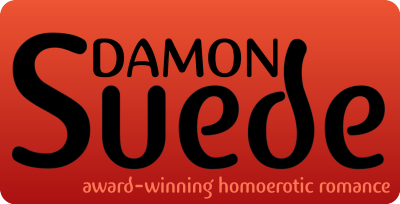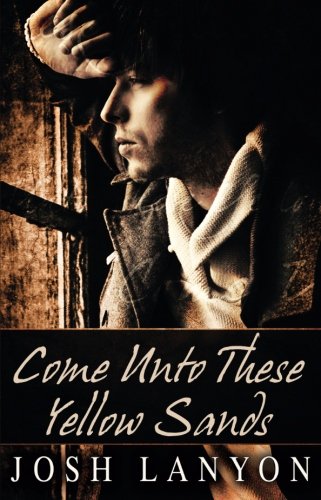Review: Come Unto These Yellow Sands
For all the brightness and beauty of this book, I’m gonna
go out on a limb and call it a noir and then
explain what the hell I mean.
Lanyon’s phenomenal grasp of mystery mechanics and flair
for M/M romance makes for a fascinating hybrid here: a romantic noir
or maybe bright noir. I don't mean the Tarantino/Miller pose of noir
or post-television noir kitsch, but the detached, harsh starkness of
pulp noir made luminous like a shadow pulled inside out. Featuring
two appealing, isolated, pained heroes, Come Unto These
Yellow Sands forces its lovers to fumble, alone and
together and apart, to solve a murder and a disappearance. The
crimes feel fresh and motivated and the intimacy scorching. Like
many classic noirs, Lanyon’s book starts with a scarred sleuth in
stasis and a frantic innocent in peril who promptly vanishes into a
fog of misread hints and facts.
Now before I start opining all over the place, a couple
things about noir....
Soaked in midcentury paranoia and unsentimental to its
core, noir has outgrown its pulpy, cinematic origins into one of the
dominant mutations of the crime genre. In pop culture, noir has
become a swaggering cartoon in a fedora... but way back at its
expressionistic roots, noir represented a shocking split with the
cozy, mannered whodunnits that had gone before. From the start, noir
was brash and brutal, using tortured protagonists, conflicted
motives, kinky violence, and a sense of paranoia to poke at the
darkness under the American Dream. (Yum!) Noir earned its name by
the shadows of its palette, and what those shadows do primarily is
obscure and frame details deceptively. Expectations are a weakness.
Snappy dialogue hides slivers of truth. Like poets and lovers, noir
foregrounds the life-and-death danger of details. In noir, the facts
must be assembled out of skewed misinterpretations and willful
blindness.
“If there was one life skill everyone on
the planet needed, it was the ability to think with critical
objectivity.”
I would argue that what Lanyon realizes and plays with in
this novel is the clear, curious overlaps between noir and gay
narrative: guilty secrets, hidden lusts, inner conflicts, ironic
consequence, even the impossible pressure to conform to a world that
devalues individuals.
By the same token, for an isolated gay man no bleak urban
landscape could generate the pressure and panic of a small, sunny
town in Maine populated by happy heteros. So Lanyon’s figurative
shadows fall inside his protagonists; clarity is impossible and
misjudgment inevitable because they cannot see and will not reveal
what they (think they) know. They flirt with addiction and betrayal.
Lanyon gives us a romantic mystery with mature heroes trying to
solve a murder and their tangled partnership at the same time.
Lanyon walks a fine line here. There’s a bleak, blunt
hopelessness throbbing under the bright streets and rooms of his
smalltown Maine setting. He blends in poetry, images, and passionate
certainty to balance and give the romance room to breathe. The
maudlin self-involvement of the bad poetry Swift wades through even
reflects noir just enough to become funny. It’s a tightrope walk
well worth the trouble because it saves the book from sentimentality
and pessimism both.
Professor and poet Swift has settled into a relationship
“left to chance” which is as puzzling and seductive as the crime at
the story’s center. Clever, Mr. Lanyon. Swift lies almost from the
moment we meet him: to Max, to his agent, to the college staff. For
someone longing for integrity and commitment, that kind of
gamesmanship rang true (and sad). His blithe detachment about the
man he loves does seem almost… well… criminal.
“The good news was he hadn’t been
arrested. He had half expected it, but there had been no word from
Max at all—that, of course, was also the bad news.”
Swift’s career stalled with a never-completed collection
called Blue Knife, the title harshly appropriate since it
hurts him so deeply and he has teetered on its edge for so long.
Actually, the color blue punctuates the book meaningfully:
poetry, institutions, mother, redemption, and more. Swift's
addictions dog him daily and he yearns for romanticism; yet like the
most masochistic noir gumshoes, he pines for Max, the one person who
could, but cannot, give it to him.
Max embodies the other type of judgmental, hard-handed
heroes who populated the pulps. He lives by a rigid code of honor
and distrusts people instinctively. His unexpected charm and gruff
bluster make for a fiercely sexy alpha male… and a believable
small-town cop. The fascination with past pain and tough decisions
makes our heroes sexier and riskier. They want to share the clear
light of day, but they can’t seem to get to it, together.
And yet this story is not noirish in its warmth, depth, and
winning detail. Minor characters present little gems of specificity.
Allusions and humor thread through entire plotlines. Lanyon serves
up unforgettable snippets of Swift’s startling childhood (which I
won’t spoil for you) and sketches his creative paralysis without
flashbacks or big slices of exposition cake. As Swift walks into the
mystery dropped on his doorstep his complicated backstory blooms
around him: the death of his father, his career’s ruin, the
addiction that silenced him, his almost-relationship.
Noir is a literature of dissatisfaction and disappointment;
its characters want what they cannot have and have what will never
want. Time passing, opportunities missed. The neat trick here is
that Lanyon uses those lacks as a spur to union. The unlikely
partnership between Swift and Max allows romance a space in all the
noir, two detectives investigating from different angles making a
perfect team.
Lanyon further isolates them, making Swift and Max the only
gay men in their tiny town, unable to be straight with each other
(in any sense of the word). They obviously love each other and yet
they lie and mistrust so easily. Sex and stakes sizzle between them.
Swift’s anxiety and Max’s outrage over their rotten behavior becomes
ours. And yet they fit beautifully, with blistering tension. Are
they together by choice or circumstance? A larger mystery, that, and
the heart of the book.
"People did terrible things to each
other—and half the time they did it by accident."
And by keeping the crime at a distance and the victim
unsympathetic, Lanyon allows his two damaged lovers a little island
of light in the middle of the nastiness. The crimes are less
important than what they reveal about Swift and (to a lesser degree)
Max. Their reunion unfolds as a slow mutual taming in which Swift’s
fire and Max’s determination fuse happily. The tenderness between
them provides perfect contrast to all the enemies from without. Once
they solve the mystery, they only have each other and only trust
each other.
My only niggle? The second-person Choose-Your-Own-Adventure
kickoff to each chapter felt like an extraneous gimmick, especially
with so many other complex threads doing heavy lifting. I kept
waiting for those “adventure spurs” to gel or land as witty
metafiction, but they seemed more like clever pop-culture fragments
hammered into service as transitions. Not dire, but not needed.
Lanyon does beautiful work here, and these two men were
winning in the extreme. Mystery is not my favorite subgenre of gay
romance; I find that machinations tend to get in the way of the
relationship, but not here. In fact, not with Lanyon, apparently.
Come Unto These Yellow Sands reflects M/M
mystery mastery throughout.
Triumphant.


